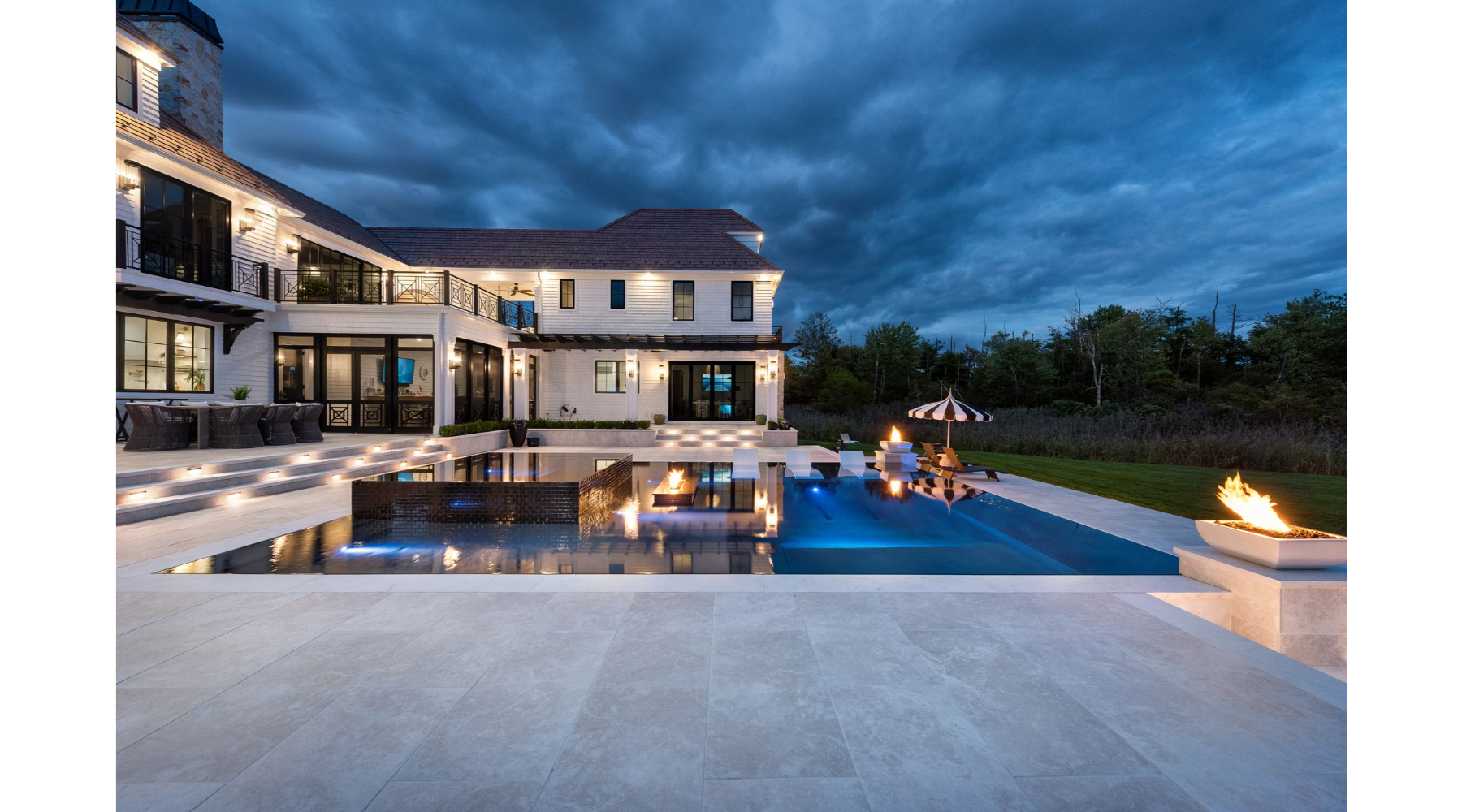
Fire and Water Features: The Ultimate Guide to Transforming Your Outdoor Living Space in 2025
The outdoor living renaissance continues to evolve in 2025, with homeowners seeking more than just functional backyards—they want immersive outdoor experiences that blend beauty, functionality, and sensory engagement. At the forefront of this transformation are fire and water features, powerful design elements that create stunning focal points while enhancing the atmosphere of any outdoor space.
In this comprehensive guide, we'll explore how combining these elemental forces can elevate your backyard from ordinary to extraordinary, with expert insights on design approaches, material selection, and the latest innovations that define luxury outdoor living.
Why Fire and Water Features Are Transforming Outdoor Design
The juxtaposition of fire and water creates a compelling visual and sensory experience that few other design elements can match. The dancing flames reflected on water surfaces generate a captivating play of light, while the contrasting sounds—crackling fire and flowing water—create a multidimensional sensory environment.
Beyond aesthetics, these features offer practical benefits that extend the functionality of your outdoor space:
- Extended seasonal use: Fire features provide warmth during cooler months, extending your outdoor living season by weeks or even months
- Enhanced property value: According to real estate experts, thoughtfully designed outdoor living spaces with premium features can increase property values by 15-20%
- Multisensory appeal: The combination engages multiple senses—visual beauty, the sound of flowing water, the warmth of fire, and even the aromatic possibilities with certain fire features
- Entertainment focal point: These features naturally draw people together, creating gathering spaces that encourage conversation and connection
Transformative Design Approaches
The Integrated Approach
The most sophisticated designs incorporate fire and water elements that physically interact, creating a harmonious relationship between opposing forces. Popular integrated approaches include:
Fire and Water Bowls
These stunning features combine a central fire element surrounded by a water channel or basin. The reflection of flames on the water surface creates mesmerizing visual effects, especially in evening settings. These versatile elements work beautifully as:
- Pool perimeter features
- Pathway markers
- Entryway statements
- Patio centerpieces
Waterfall Fire Features
These dramatic installations position fire elements behind or beneath flowing water, creating the illusion of "fire on water." These statement pieces become instant conversation starters and transform ordinary pool edges or water features into extraordinary focal points.
Fire Troughs with Water Elements
Linear fire features paired with parallel water troughs create contemporary, architectural statements perfect for modern design aesthetics. These elements can define space boundaries or serve as dramatic dividers between functional zones in your outdoor living space.
The Complementary Approach
For more flexibility or when working with existing landscapes, positioning separate fire and water features in proximity creates a complementary relationship without physical integration:
Strategic Positioning
Placing a fire pit or table near a fountain, pool, or water feature creates a natural gathering area that benefits from both elements while maintaining the distinct character of each. This approach allows for:
- Greater flexibility in use and positioning
- Easier maintenance
- The ability to use each feature independently
- Simplified winterization in colder climates
Visual Alignment
Creating sightlines that incorporate both elements ensures they work together visually even when physically separated. Consider how the features will be viewed from different vantage points—especially from indoor spaces that overlook your outdoor area.
Material Selection: The Foundation of Lasting Luxury
The materials you choose for your fire and water features significantly impact their longevity, maintenance requirements, and aesthetic integration with your overall design. Here's a breakdown of premium material options and their characteristics:
For Fire Features
| Material | Characteristics | Best For |
|---|---|---|
| Cast Concrete | Exceptional durability, customizable colors and textures, heat-resistant, modern aesthetic | Contemporary designs, custom shapes, coastal environments |
| Copper | Develops a natural patina over time, antimicrobial properties, warm tones, striking with flames | Traditional and transitional styles, luxury appearance, longevity |
| Corten Steel | Controlled rusting creates a protective layer, warm earth tones, industrial aesthetic | Modern and industrial designs, low-maintenance needs |
| Natural Stone | Unique character, extreme durability, timeless appeal, natural integration with landscapes | Traditional designs, permanent installations, seamless landscape integration |
For Water Features
| Material | Characteristics | Best For |
|---|---|---|
| Natural Stone | Timeless appeal, unique character, excellent durability | Traditional and natural landscape designs |
| Architectural Concrete | Design flexibility, color consistency, modern aesthetic | Contemporary designs, custom shapes and formats |
| Ceramic Tile | Unlimited color options, reflective qualities, pattern possibilities | Mediterranean designs, colorful accents, custom patterns |
| Metal Accents | Modern industrial feel, water-flow control, dramatic effects | Contemporary designs, water walls, directional features |
Fuel Options for Fire Features
The fuel source you select impacts aesthetics, convenience, maintenance requirements, and operational costs. Modern fire features offer several options:
Natural Gas
Pros:
- Consistent, reliable flame
- No fuel storage needed
- Lowest operational cost
- Always ready to use
- Cleanest burning fossil fuel
Cons:
- Requires permanent gas line installation
- Less flexibility in repositioning
- Professional installation required
- Higher initial installation cost
Propane
Pros:
- Portable options available
- More flexible positioning
- No permanent gas line needed
- Readily available fuel
- Clean burning with minimal residue
Cons:
- Requires tank storage (though many designs conceal tanks)
- Higher fuel cost than natural gas
- Tank replacement/refilling needed
- Slightly different flame characteristics than natural gas
Bioethanol
Pros:
- No venting or chimney required
- Clean burning with no smoke or ash
- Flexible installation options
- Environmentally friendly renewable fuel
- Modern aesthetic
Cons:
- Lower heat output than gas options
- Higher fuel cost
- Shorter burn time per refill
- Limited flame adjustment
Wood
Pros:
- Authentic crackling fire experience
- Highest heat output
- Traditional ambiance and aroma
- No fuel costs if you have access to wood
- Independent operation (no utilities needed)
Cons:
- Requires cleaning after each use
- Smoke and ash management
- Wood storage needed
- May have restrictions in some communities
- More involved startup and maintenance
Water Feature Considerations
Water Circulation Systems
The pump and circulation system are the heart of any water feature. For reliable performance and energy efficiency, consider:
- Variable speed pumps that adjust flow based on needs
- Energy-efficient motors that reduce operational costs
- Properly sized systems that balance flow with energy consumption
- Filtration components that reduce maintenance and water treatment needs
Lighting Integration
Integrating lighting with water features dramatically extends their impact into evening hours:
- LED underwater lights that highlight water movement
- Color-changing options for different moods and occasions
- Smart controls that synchronize lighting with other landscape elements
- Energy-efficient systems that minimize operational costs
Water Conservation Features
Modern water features incorporate conservation measures:
- Recirculation systems that minimize water consumption
- Rain sensors that adjust operation during precipitation
- Auto-fill mechanisms that maintain optimal levels
- Properly sealed basins that reduce evaporation and leakage
Real-World Transformations: Case Studies
Coastal Contemporary Retreat
Project Overview: A waterfront property in California sought to maximize ocean views while creating intimate gathering spaces for year-round entertaining.
The Transformation: A series of three interconnected fire and water bowls were installed along the ocean-facing edge of an elevated patio. The water elements create a visual connection to the ocean beyond, while the fire components provide warmth and light for evening gatherings.
Key Design Elements:
- Cast concrete construction with a custom color blend that complements the coastal environment
- LED lighting that transitions through a subtle color palette mimicking sunset tones
- Natural gas fuel for consistent, maintenance-free operation
- Smart controls that allow remote operation via smartphone
Client Feedback: "The fire and water features have become the centerpiece of our outdoor entertaining. Guests naturally gather around them, and they've extended our outdoor season well into the cooler months."
Woodland Modern Escape
Project Overview: A wooded property in the Pacific Northwest needed all-season outdoor living solutions that would integrate with the natural surroundings.
The Transformation: A large central fire table with water channels was installed as the centerpiece of a covered outdoor room. The water component reflects both the fire and the surrounding tree canopy, while the substantial fire element provides significant heat for year-round use.
Key Design Elements:
- Corten steel construction that develops a natural patina blending with the forest environment
- Tempered glass wind guards that maximize heat retention while maintaining visibility
- Propane fuel with a concealed tank chamber for flexibility
- Natural stone surrounds that integrate with existing landscape elements
Client Feedback: "We use our outdoor space nearly year-round now, which was unimaginable before. The combination of fire warmth and the soothing water sounds creates an atmosphere that feels both energizing and relaxing."
Practical Implementation Considerations
Budget Planning
Quality fire and water features represent a significant investment in your outdoor living space. Understanding the cost components helps in planning:
Entry-Level Integration (Starting around $5,000)
- Pre-fabricated fire bowls with simple water elements
- Standard finishes and materials
- Limited size and scale
- Basic installation without extensive site preparation
Mid-Range Custom Solutions ($10,000-$25,000)
- Custom-sized features
- Premium materials and finishes
- Professional design integration
- Enhanced control systems
- Lighting integration
Luxury Integrated Systems ($25,000+)
- Fully custom designs
- Architectural integration with existing structures
- Premium materials and craftsmanship
- Comprehensive control systems
- Multiple features working in harmony
Note: These price ranges are estimates only and may vary considerably based on factors including location, specific product selections, site conditions, and installation requirements. We recommend consulting with a landscape professional for a detailed quote specific to your project.
Installation Timelines
Proper planning accounts for realistic implementation schedules:
-
Design and Approval Phase: 2-6 weeks
- Site assessment and concept development
- Material selection and specification
- Utility planning (gas, electric, water)
- Permit acquisition if required
-
Site Preparation: 1-2 weeks
- Excavation and grading
- Utility connections
- Foundation preparation
-
Installation: 1-3 weeks
- Feature construction or placement
- System connections and testing
- Surrounding landscape restoration
-
Final Detailing: 3-5 days
- System calibration
- Aesthetic finishing
- Client training on operation and maintenance
Maintenance Considerations
To protect your investment and ensure long-term enjoyment, understand the maintenance requirements:
Seasonal Maintenance
- Spring startup procedures
- Fall winterization in cold climates
- Seasonal deep cleaning
- System checks and servicing
Routine Care
- Water treatment and monitoring
- Surface cleaning and protection
- Fuel system maintenance
- Mechanical component inspection
Professional Support
- Annual service contracts
- System upgrades and enhancements
- Troubleshooting assistance
- Warranty service
Technology Integration: Smart Features for Modern Living
Contemporary fire and water features can incorporate technology that enhances convenience, efficiency, and enjoyment:
Remote Control Systems
Modern systems offer multiple control options:
- Smartphone apps for remote operation
- Voice control through home automation systems
- Programmable schedules for regular use patterns
- Integration with other outdoor systems (lighting, audio)
Weather Responsiveness
Smart features can adapt to environmental conditions:
- Wind sensors that adjust flame height or shut off in high winds
- Temperature-responsive operation that increases output in cooler conditions
- Rain sensors that protect water features during heavy precipitation
- Freeze protection for cold-climate installations
Entertainment Integration
Enhanced systems connect with other outdoor entertainment elements:
- Synchronized lighting effects that respond to music
- Integrated audio systems
- Choreographed water movement for special occasions
- Scene setting that coordinates multiple outdoor elements
Choosing the Right Solution for Your Space
Every outdoor environment has unique characteristics that influence the optimal fire and water feature selection. Consider these factors when planning:
Climate Considerations
Your local climate significantly impacts both design and material choices:
Hot, Dry Climates
- Prioritize water conservation features
- Consider cooling water effects
- Select heat-resistant materials
- Plan for sun exposure and shade integration
Cold Climates
- Focus on freeze protection and winterization
- Emphasize heat output from fire elements
- Consider covered or sheltered placements
- Select materials that handle freeze-thaw cycles
Coastal Environments
- Choose salt-resistant materials
- Plan for wind protection
- Accommodate humidity effects
- Consider corrosion-resistant components
Space Analysis
The available space shapes both possibilities and limitations:
Compact Spaces
- Consider wall-mounted or vertical designs
- Explore dual-purpose features that combine functions
- Scale appropriately to avoid overwhelming the area
- Focus on space-efficient solutions
Expansive Areas
- Create focal zones that draw people to specific areas
- Consider multiple feature locations for different uses
- Scale features to maintain visual impact across distances
- Plan viewing perspectives from multiple vantage points
Challenging Topography
- Leverage elevation changes for dramatic water effects
- Consider terraced designs that work with natural contours
- Use features to highlight and enhance natural landscape elements
- Address drainage and water management proactively
Premium Products for Your Outdoor Vision
At BackyardEmber, we carefully curate a selection of premium fire and water features to help transform your outdoor living space:
Quality and Craftsmanship
Each product in our collection is selected for:
- Exceptional build quality and durability
- Premium materials and finishes
- Distinctive design elements
- Reliable performance in various environments
Expert Selection Guidance
While browsing our collection, you'll find:
- Detailed specifications to inform your decision
- High-quality images showcasing each product
- Compatibility information for various settings
- Clear pricing and availability details
Premium Brands
We partner with industry-leading manufacturers known for:
- Innovative design approaches
- Superior materials and construction
- Reliable warranty coverage
- Established reputations for excellence
FAQ: Common Questions About Fire and Water Features
Q: How much does it cost to operate a gas fire feature?
A: Natural gas fire features typically cost between $0.50 and $2.00 per hour of operation, depending on size, BTU output, and local gas rates. Propane units generally cost about twice as much to operate as natural gas.
Q: Are permits required for installing fire and water features?
A: Permit requirements vary by location. Generally, permanent gas line installations require permits and inspection, while many self-contained propane or bioethanol features don't. Water features that modify existing plumbing systems often require permits. Our team handles all permitting requirements as part of our installation process.
Q: How do you protect water features in freezing temperatures?
A: In cold climates, water features either need to be winterized (drained and protected) or equipped with freeze protection systems that maintain water movement and/or heating elements that prevent freezing. We design all our cold-climate installations with appropriate freeze protection measures.
Q: Can fire and water features be installed on existing patios?
A: Yes, with proper evaluation. We assess the existing structure for weight capacity, access to utilities, and safety considerations. Many of our designs can be adapted for installation on existing hardscapes, while others may require foundation modifications or new construction.
Q: What safety features are included with modern fire elements?
A: Contemporary fire features incorporate multiple safety systems, including:
- Automatic shut-off if flame detection sensors indicate problems
- Wind sensors that reduce or extinguish flames in high winds
- Timed operation that prevents unattended use
- Child-safety locks on control systems
- Emergency stop controls
Q: How difficult is maintenance for combined fire and water features?
A: Our integrated designs minimize maintenance requirements through:
- Self-cleaning water circulation systems
- Corrosion-resistant materials
- Accessible components for easy servicing
- Automation that maintains optimal operation
- Optional maintenance service programs
Conclusion: Creating Your Elemental Oasis
The thoughtful integration of fire and water into your outdoor living space creates more than just a beautiful environment—it crafts an experience that engages the senses and creates a backdrop for meaningful moments. As we move through 2025, the trend toward creating these immersive outdoor environments continues to grow, with innovations making these features more beautiful, efficient, and accessible than ever before.
Whether you're considering a dramatic focal point for entertaining or a serene retreat for daily enjoyment, the combination of fire and water elements offers endless possibilities for transforming your outdoor space into a personal sanctuary that reflects your style and enhances your lifestyle.
Ready to explore how fire and water features could transform your outdoor living experience? Browse our premium collection to discover the perfect elements for your space.
This guide is regularly updated to reflect the latest trends, technologies, and design approaches in outdoor living. Last updated: May 2025.

